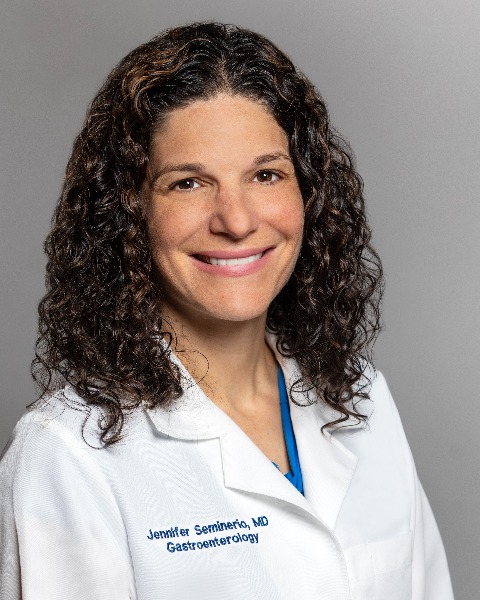Monday Poster Session
Category: IBD
P3339 - Ulcerative Colitis Predominates, Yet Hepatic Progression Mirrors Crohn’s in Primary Sclerosing Cholangitis–Inflammatory Bowel Disease Overlap: A Tertiary Cohort Study
Monday, October 27, 2025
10:30 AM - 4:00 PM PDT
Location: Exhibit Hall

Jennifer Seminerio-Diehl, MD (she/her/hers)
Director Inflammatory Bowel Disease
Department of Gastroenterology and Hepatology, AdventHealth Orlando
Orlando, FL
Presenting Author(s)
Jennifer Seminerio, MD1, Sunny Kahlon, BS2, Megan Pearce, DNP, APRN, FNP-C3, Donna Ortiz, DNP, APRN, FNP-C1, Rahul Mhaskar, MD4
1Department of Gastroenterology and Hepatology, AdventHealth Orlando, Orlando, FL; 2USF Health Morsani College of Medicine, Allentown, PA; 3AdventHealth, Orlando, FL; 4James A. Haley Veterans' Hospital, Tampa, FL
Introduction: Primary sclerosing cholangitis (PSC) frequently co‐occurs with inflammatory bowel disease (IBD), yet there is limited literature on the impact of IBD subtype on PSC. Our aim was to characterize the clinical profile and liver‐related outcomes of patients with concomitant PSC and IBD cared for at a tertiary inflammatory bowel disease center.
Methods: We performed a retrospective cohort study of all PSC–IBD patients evaluated from October 2019 to June 2024. Demographic data, endoscopic scores, laboratory values (calprotectin, CRP, AST, ALT) and clinical outcomes were abstracted. Kaplan–Meier analysis compared time from (i) IBD diagnosis and (ii) PSC diagnosis to cirrhosis, liver transplantation, and all-cause mortality between ulcerative colitis (UC) and Crohn’s disease (CD) subgroups.
Results: Forty-eight patients met inclusion criteria (UC = 36, CD = 12). Mean age at IBD diagnosis was 29.3 y (UC) versus 25.8 y (CD); mean age at PSC diagnosis was similar (33.5 y vs 33.9 y). Most patients (96%) were diagnosed with IBD before PSC. Cirrhosis was documented in 50.0% of UC and 41.7% of CD patients; prior liver transplantation in 47.2% and 25.0%, respectively. Cholangiocarcinoma occurred in 11% of the UC patients. Median endoscopic activity was mild (Mayo 1.08 ± 0.25) in UC but higher in CD (SES-CD 9.3 ± 5.7). Serial inflammatory markers did not reliably distinguish disease course. Kaplan–Meier curves demonstrated no significant difference between the UC and CD groups in progression to cirrhosis (p = 0.32), transplant (p = 0.59), or overall survival (p = 0.26).
Discussion: In this tertiary cohort, UC was three times more common than CD among PSC–IBD patients; however, once PSC developed, liver-related outcomes did not differ by IBD subtype. These findings highlight the need for vigilant, multidisciplinary follow-up for all PSC–IBD patients regardless of underlying bowel phenotype and support larger, prospective studies to identify markers that predict hepatic progression.
Disclosures:
Jennifer Seminerio: Abbvie – Consultant. Johnson & Johnson – Consultant. Lilly – Consultant. Pfizer – Consultant. Sanofi – Consultant. Takeda – Consultant.
Sunny Kahlon indicated no relevant financial relationships.
Megan Pearce: Johnson and Johnson – Advisor or Review Panel Member.
Donna Ortiz: Abbvie – Consultant, Speakers Bureau. BMS – Speakers Bureau. Celltrion – Speakers Bureau. Johnson & Johnson – Advisor or Review Panel Member, Speakers Bureau. Lilly – Consultant, Speakers Bureau.
Rahul Mhaskar indicated no relevant financial relationships.
Jennifer Seminerio, MD1, Sunny Kahlon, BS2, Megan Pearce, DNP, APRN, FNP-C3, Donna Ortiz, DNP, APRN, FNP-C1, Rahul Mhaskar, MD4. P3339 - Ulcerative Colitis Predominates, Yet Hepatic Progression Mirrors Crohn’s in Primary Sclerosing Cholangitis–Inflammatory Bowel Disease Overlap: A Tertiary Cohort Study, ACG 2025 Annual Scientific Meeting Abstracts. Phoenix, AZ: American College of Gastroenterology.
1Department of Gastroenterology and Hepatology, AdventHealth Orlando, Orlando, FL; 2USF Health Morsani College of Medicine, Allentown, PA; 3AdventHealth, Orlando, FL; 4James A. Haley Veterans' Hospital, Tampa, FL
Introduction: Primary sclerosing cholangitis (PSC) frequently co‐occurs with inflammatory bowel disease (IBD), yet there is limited literature on the impact of IBD subtype on PSC. Our aim was to characterize the clinical profile and liver‐related outcomes of patients with concomitant PSC and IBD cared for at a tertiary inflammatory bowel disease center.
Methods: We performed a retrospective cohort study of all PSC–IBD patients evaluated from October 2019 to June 2024. Demographic data, endoscopic scores, laboratory values (calprotectin, CRP, AST, ALT) and clinical outcomes were abstracted. Kaplan–Meier analysis compared time from (i) IBD diagnosis and (ii) PSC diagnosis to cirrhosis, liver transplantation, and all-cause mortality between ulcerative colitis (UC) and Crohn’s disease (CD) subgroups.
Results: Forty-eight patients met inclusion criteria (UC = 36, CD = 12). Mean age at IBD diagnosis was 29.3 y (UC) versus 25.8 y (CD); mean age at PSC diagnosis was similar (33.5 y vs 33.9 y). Most patients (96%) were diagnosed with IBD before PSC. Cirrhosis was documented in 50.0% of UC and 41.7% of CD patients; prior liver transplantation in 47.2% and 25.0%, respectively. Cholangiocarcinoma occurred in 11% of the UC patients. Median endoscopic activity was mild (Mayo 1.08 ± 0.25) in UC but higher in CD (SES-CD 9.3 ± 5.7). Serial inflammatory markers did not reliably distinguish disease course. Kaplan–Meier curves demonstrated no significant difference between the UC and CD groups in progression to cirrhosis (p = 0.32), transplant (p = 0.59), or overall survival (p = 0.26).
Discussion: In this tertiary cohort, UC was three times more common than CD among PSC–IBD patients; however, once PSC developed, liver-related outcomes did not differ by IBD subtype. These findings highlight the need for vigilant, multidisciplinary follow-up for all PSC–IBD patients regardless of underlying bowel phenotype and support larger, prospective studies to identify markers that predict hepatic progression.
Disclosures:
Jennifer Seminerio: Abbvie – Consultant. Johnson & Johnson – Consultant. Lilly – Consultant. Pfizer – Consultant. Sanofi – Consultant. Takeda – Consultant.
Sunny Kahlon indicated no relevant financial relationships.
Megan Pearce: Johnson and Johnson – Advisor or Review Panel Member.
Donna Ortiz: Abbvie – Consultant, Speakers Bureau. BMS – Speakers Bureau. Celltrion – Speakers Bureau. Johnson & Johnson – Advisor or Review Panel Member, Speakers Bureau. Lilly – Consultant, Speakers Bureau.
Rahul Mhaskar indicated no relevant financial relationships.
Jennifer Seminerio, MD1, Sunny Kahlon, BS2, Megan Pearce, DNP, APRN, FNP-C3, Donna Ortiz, DNP, APRN, FNP-C1, Rahul Mhaskar, MD4. P3339 - Ulcerative Colitis Predominates, Yet Hepatic Progression Mirrors Crohn’s in Primary Sclerosing Cholangitis–Inflammatory Bowel Disease Overlap: A Tertiary Cohort Study, ACG 2025 Annual Scientific Meeting Abstracts. Phoenix, AZ: American College of Gastroenterology.
